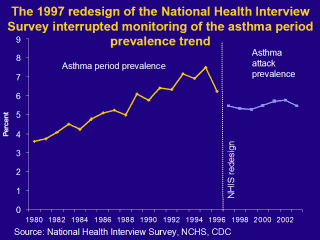| front |1 |2 |3 |4 |5 |6 |7 |8 |9 |10 |11 |12 |13 |14 |15 |16 |17 |18 |19 |20 |21 |review |
 |
However, in 1997,
the main tool for asthma surveillance changed, thus creating a break in our
ability to monitor the trend in asthma period prevalence. The National
Health Interview Survey (NHIS) is an annual health survey that provides
health statistics for the nation, including asthma prevalence estimates. The
NHIS underwent a major redesign in 1997 to improve the survey. The
redesigned survey produces estimates for asthma attack prevalence.
Although the estimates from the redesigned survey are not comparable with
previous estimates, comparing the estimates across the break in the data
trend could create an impression that childhood asthma prevalence may have
recently declined. This impression is compounded by the 1996 estimate (6.2%
versus 7.5% in 1995). However, the 1996 estimate has an increased sampling
error because the 1996 sample was reduced by 40% due to pretesting of the
redesigned NHIS that year. Because the wide 95% confidence interval around
the 1996 estimate (not shown) overlaps with the value of the 1995 estimate,
it is not clear how to interpret this data point. No part of the 1996 or 1997 NHIS sample received both the pre- and post-redesign questions to directly measure the impact of the redesign on NHIS asthma prevalence estimates. We undertook an analysis to try to estimate this impact to help researchers and public health officials understand the effect of the redesign on asthma trends. The next few slides introduce some background information for the NHIS. |